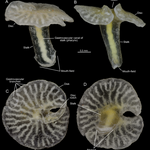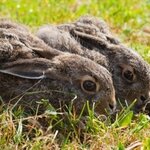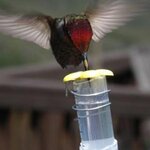Evolution

Gibbons are small, tree-living apes from Southeast Asia, many species of which are endangered. They are part of the same superfamily as humans and great apes, but sit on the divide between Old-World monkeys and the great apes.
These creatures have several distinctive traits, such as an unusually large number of chromosomal rearrangements, and different numbers of chromosomes are seen in individual species.
Researchers recently completed analysis of the mobile elements in the gibbon genome. This included the characterization of the mobile genetic element called LAVA. LAVA is made up of…

New whale research has turned a long-accepted evolutionary assumption on its...hips. Instead of being just vestigial, whale pelvic bones play a key role in reproduction, according to a new study.
Both whales and dolphins have pelvic (hip) bones, evolutionary remnants from when their ancestors walked on land more than 40 million years ago. Common wisdom has long held that those bones are simply vestigial, slowly withering away like tailbones have in humans. But a new paper by USC and the Natural History Museum of Los Angeles County finds that not only do those pelvic bones serve a…

The coffee plant has a newly sequenced genome and that can tell scientists what they really want to know about: the evolution of caffeine.
The sequences and positions of genes in the coffee plant show that they evolved independently from genes with similar functions in tea and chocolate, which also make caffeine. Coffee did not inherit caffeine-linked genes from a common ancestor, but instead developed the genes on its own.
Why Coffee?
With more than 2.25 billion cups consumed daily worldwide, coffee is the principal agricultural product of many tropical countries. According to estimates by…

In 1986, an expedition off the South-East coast of Australia near Tasmania, from depths of between 400 and 1,000 metres, brought up some jelly-like creatures, which were seen to be unusual and immediately preserved in ethanol. Now they have been examined, and assigned to a new genus Dendrogramma (from their resemblance to a tree diagram), with two species D. enigmatica and D. discoides.
Here (picture attribution)are some labelled specimens of D. enigmatica: note that the creatures themselves are only two or three millimetres in size.
They do not possess left-right symmetry, so they do not…

Most living mammals are nocturnal and it has long been thought that the transition to nocturnality occurred at about the same time as mammals evolved, around 200 million years ago. That hypothesis was based on features such as the large brains of mammals (good for processing information from senses like hearing, touch, and smell) and the details of light-sensitive chemicals in the eyes of mammals.
It turns out that nocturnal activity might have a much older origin among ancient mammal relatives, called synapsids.
The new insights come from an analysis of tiny bones, called scleral ossicles,…

Why wild animals genetically changed into domesticated forms has long been a mystery, covered by the blanket artificial selection reasoning.
A new paper in Science says that many genes controlling the development of the brain and the nervous system were particularly important for rabbit domestication.
The domestication of animals and plants, a prerequisite for the development of agriculture, is one of the most important technological revolutions during human history. Domestication of animals started as early as 9,000 to 15,000 years ago and initially involved dogs, cattle, sheep, goats…

Although separated by hundreds of millions of years of evolution, flies, worms, and humans share ancient patterns of gene expression and it's all in our genomic data.
Three related studies in Nature, tell a similar story: even though humans, worms, and flies bear little obvious similarity to each other, evolution used remarkably similar molecular toolkits to shape them.
There are dramatic differences between species in genomic regions populated by pseudogenes, molecular fossils of working genes, according to Yale authors in Proceedings of the National Academy of Sciences.
The human, worm, and…

Organisms in a symbiotic relationship will often shed genes as they come to rely on the other organism for crucial functions but researchers have uncovered an unusual event in which a bacterium that lives in a type of cicada split into two species - doubling the number of organisms required for the symbiosis to survive.
Cicadas of the genus Tettigades feed only on sap they suck out of plants. To create some of the essential amino acids they rely on two bacterial helpers — Candidatus Hodgkinia cicadicola and Candidatus Sulcia muelleri — with which they have lived in symbiosis for millions of…

If you capture a hummingbird on high-speed video and slow it down, their wings thrum like helicopter blades as they hover near food. Their hearts beat 20 times a second and their tongues dart 17 times a second to slurp from a feeding station.
It takes only three licks of their forked, tube-like tongues to reject water when they expect nectar. They pull their beaks back, shake their heads and spit out the tasteless liquid.
Want to make a hummingbird mad? Give them no-calorie diet soda.
Evolution at a molecular level explains what anyone with a backyard birdfeeder knows: Hummingbirds have a…

Humans don't want to live above the West Antarctic ice sheet but microbes can certainly live below it, according to a new study. Even half a mile below it.
The waters and sediments of a lake 2,600 feet beneath the surface of the West Antarctic ice sheet support "viable microbial ecosystems", according to recent results. Given that more than 400 subglacial lakes and numerous rivers and streams are thought to exist beneath the Antarctic ice sheet, such ecosystems may be widespread and may influence the chemical and biological composition of the Southern Ocean, the vast and biologically…